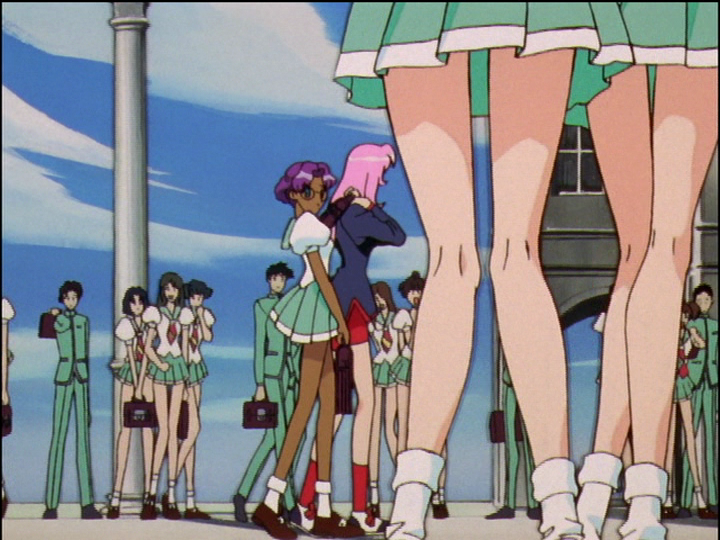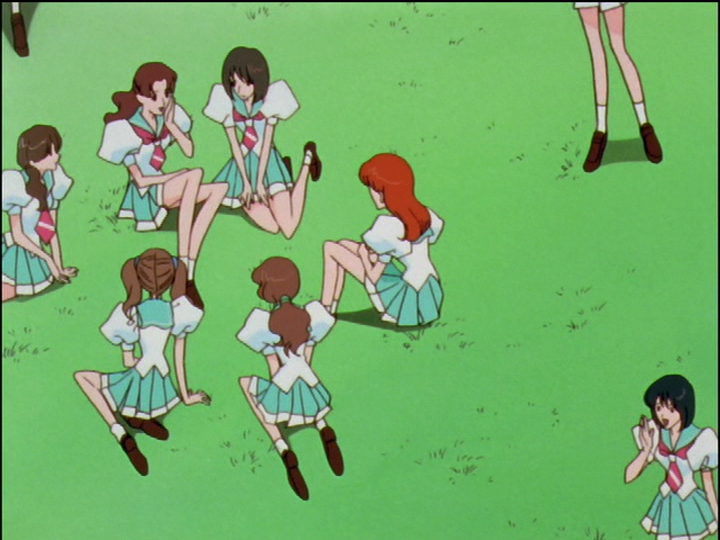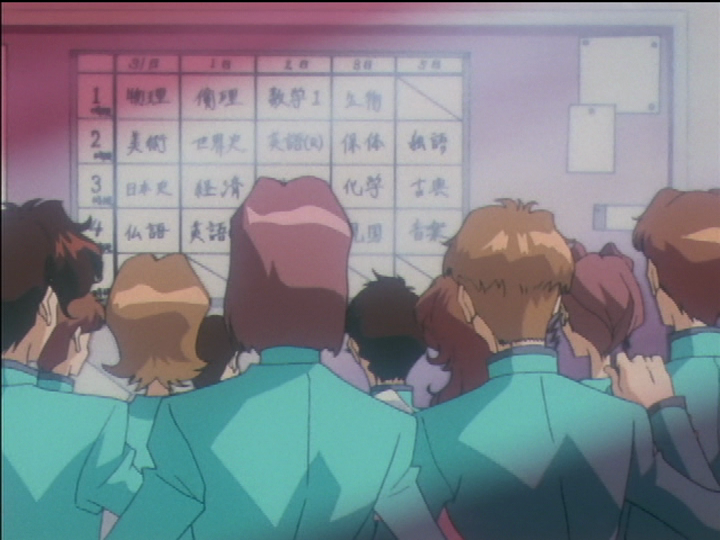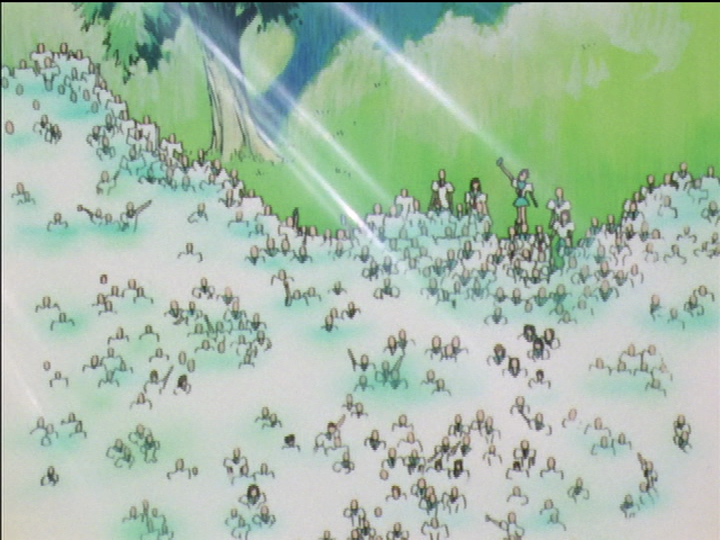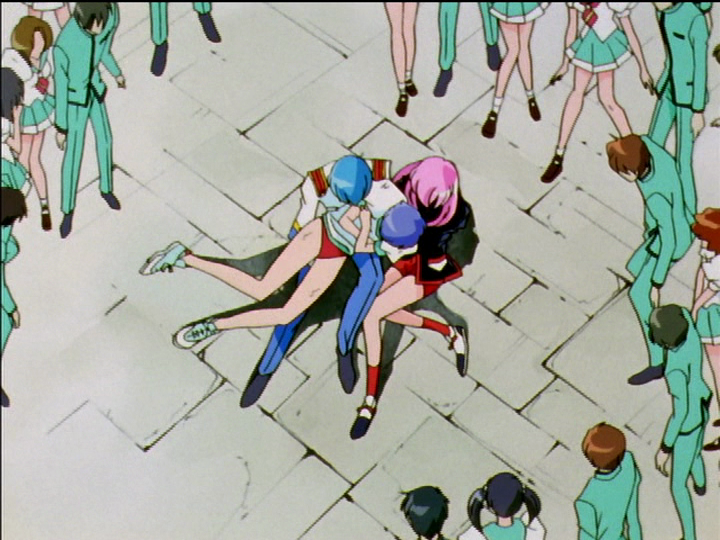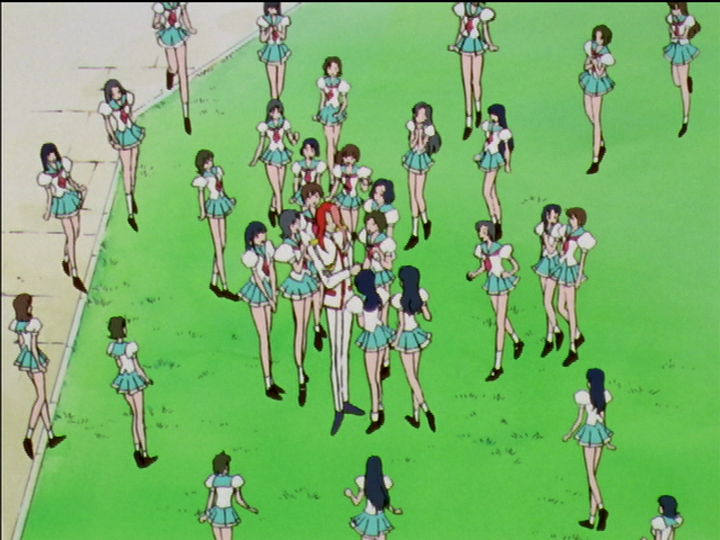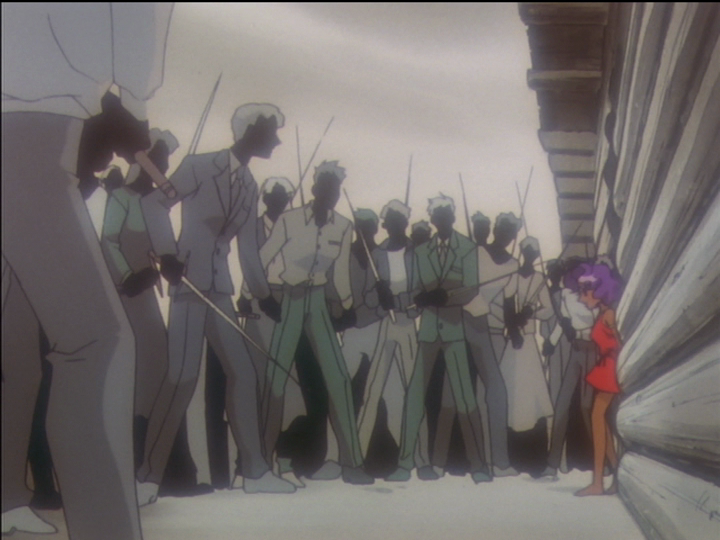Utena - crowd catalog
Images of crowds, especially the larger crowds.
As a first take, a crowd indicates common interest in something that the crowd has gathered around. Some may only be people gathering where it’s convenient for them to be, for example between classes. I want to look for deeper connections.
The windows (see arches and windows) are full of girls watching Utena beat the boys’ team at basketball. A smaller group watches from ground level. Aside from the female prince trope (essentially the same as in Onii-sama e), what draws them to Utena? Are they impressed by her coolness and skill? By her unconventionality? Are they attracted because she is boyish? And why are boys uninterested? It is because Utena denies and defies the patriarchal system of control. The system harms girls, and they (I’m sure mostly unconsciously) admire Utena’s rebellion. The system benefits boys, and boys are unimpressed.
Like most things, the basketball net is symbolic, with a ring and a red pole to tie it to male power. Putting the ball through the net... is meaningful. Utena’s basketball wins are exercises of male sexual power, and in the two later games she grasps the rim. It seems to forecast that Utena as a prince may come to control Anthy. There are other interpretations. The ball is a female symbol and the net is a vagina, so it is a yuri symbol. The ball is the egg of the world, and Utena holds control over it, ambiguously. But she wins.
We are shown the crowd around Wakaba’s letter to Saionji from several angles. See comparisons - bulletin board for a silhouette view, and comparisons - hand on shoulder for one meaning behind the image.
In Utena-world, only boys are drawn to gather around a love letter posted on the bulletin board. Wakaba and Utena stopped out of curiosity—what is this crowd for? The sex self-segregation is pretty solid at Ohtori Academy. Similar crowds gather in episode 10, Saionji’s expulsion notice (regularly arranged boys and girls), and episode 15, the final exam schedule (irregularly arranged boys and girls).
On the way to class, groups of students line the path, self-segregated into boy- and girl-groups. Everybody seems to be looking at Utena, but only the girls call out in greeting. In closer shots Anthy looks at Utena, but here her eyes are on the crowd. Is Anthy fearful of the crowd (as in the picture directly below), or is she curious, feeling safe because its attention is directed away from her? Maybe she is only watchful; see cool stuff - Anthy is highly observant.
The girls blush for attraction to boyish Utena, or feel bashful in her illustrious presence, part of the trope. The boys do not call out to the one who threatens to usurp their power. But Touga is different and does call out to her. You could say it’s because he’s a princess—though he claims to be a wholesome boy.
Anthy at the dance party has been brought onto the floor by Nanami and abandoned there. With her fear of crowds, she perceives the crowd around her as dense and focused on her. Her perception must be exaggerated, but it’s not unmotivated. She is regularly blamed for things that are not her doing (never mind that she gets away with many undetected evils). Anthy learned her fear of crowds in episode 34. Prominent colors are green for control and purple for corruption, and there are others.
One of Akio’s illusions is that Anthy is a witch. That’s why she is blamed. The rumors are false because Anthy commits much greater evils.
From Miki’s childhood memory. Faced with the prospective concert, little Kozue says she is afraid to appear in front of so many strangers. Fear of crowds is part of Kozue’s parallel with Anthy. Her poor self-confidence suggests that she has internalized a “weaker sex” role: Miki is a genius who deserves the credit and she’s only following his lead, she believes. She plays the piano well when the black rose causes her to lose her fear.
Kozue is on a blue background for illusion, quickly shading into purple. It is Miki’s point of view, so it is Miki’s illusion that the concert will go well. I think the purple is for Miki’s self-perceived corruption in forcing her to play. It was a bad thing to do, but he was a little kid and he exaggerates his guilt. Kozue wears purple as well, which shows her aims. She is turning corrupt.
For the hair bow, see the comparison with a shadow girl.
Touga has defeated the boxing kangaroo, which is flat on its back. A crowd has gathered around the spectacle. There are roughly equal numbers of boys and girls. The day is late, the shadows are long, and the colors are trending to sunset. Approaching night signals Akio’s dark corruption: It was part of a plot by Akio-wannabe Touga to manipulate Utena. The crowd stands in the shape of a ring, which in this case is a boxing ring. Actually, the ring is a bit egg-shaped. Maybe the people in the middle are growing and developing inside the egg of the world.
Some people cast shadows. Some do not. Some shadows do not have people. Touga, Nanami, and the kangaroo cast shadows, suggesting that they are more aligned with Akio, while Utena, Miki, and Mitsuru do not.
Juri and Utena are at the window, talking and looking out at students between classes. The girls and boys have self-segregated, and they are engaged in Akio-approved gender-appropriate behavior: The girls are sitting on the soft grass talking, the boys are on the hard pavement, carrying brooms and playing at sword-fighting. Well, one boy has a limp mop. They have learned their roles well—except the red-haired girl, who is sitting with a somewhat boyish posture (though her legs are girlishly together).
At the moment, Juri and Utena are conforming to their sex roles, talking through the cages of the windows. Later in the episode, they break from their roles and duel in the paved dueling arena. The images say that Juri and Utena are alike in that way.
Anthy and Utena are walking to school. Wakaba runs up to jump on Utena. If you’re sensitive to body language, it’s instantly clear that the two have been reversed. “Anthy” carries her briefcase confidently over her shoulder, and “Utena” carries it defensively in front with joined hands. To maintain the surprise, the camera stays in close at first, making it harder to notice, and only cuts to this wide view at the last moment.
Anthy arranged it, and she is mostly on the dark side of the shadow line. Except that, oops, that’s actually Utena. The shadow line is participating in the deception to keep the audience in the dark. Seconds later, “Utena” gets pink spinning roses. In the next scene, as Nanami’s minions try to harrass “Anthy”, Utena acts as a boy and defends herself, but she retains Anthy’s long fingernails. The symbols are teasing us, or rather, even the show’s reality is an illusion (see Buddhism).
A notice is posted about Saionji’s expulsion. Juri and Miki stand apart, but a crowd has gathered around the notice. Utena is in the crowd.
The rear row of the crowd is arranged boy-girl-boy-Utena-boy-girl-boy-girl. Juri and Miki continue the pattern leftward, Juri supported by a male column and Miki framed in a female arch for their non-conventional gender identities. I don’t know what the orderly pattern means, beyond that everyone is interested—and that Utena is treated by the crowd as female. It does align with the shadows of the orderly male columns and female arches of the colonnade, though. The crowd is beyond a square opening that contrasts with the rounded arches. Juri’s shadow looks meaningful.
There are 100 Black Rose boys under Mikage. This is 50 of them. They are on a black background for the darkness of Mikage’s underworld realm of death. They start out facing away from the camera, but turn their heads in unison, in what feels like a horror movie shot. Are they monsters or victims? I think both. Of course Mikage sacrifices them all at the end of the arc (which we see late, but it happens before any of Utena’s duels). Before then, they didn’t seem to mind seeing one of their number wheeled past in a coffin. No doubt they killed each other in duels, seeking the way to progress. Is this after 50 fatal duels?
The all-male research team suggests a past which was more firmly patriarchal than Akio’s present. Maybe it means that Utena is not the first to defeat Akio, but only the latest. But maybe the change since then has been slow rather than revolutionary.
The schedule of end-of-term final exams. See translation notes - finals schedule. One boy has a hand on another boy’s shoulder, a callback to the crowd around Wakaba’s letter in episode 1. The boys and girls are mixed together; no sex self-segregation this time.
The bulletin board is tinted purple for corruption. The schedule itself is innocuous, so I guess the corruption is provided by the notice to Utena (not visible in this view) to show up for a duel.
Nanami throws a party to show off her new jewelry, but changes plans when fancier jewelry arrives. The party is about social status, and everyone is dressed up. The crowd is majority female. A few of the men have hands casually in pockets. They are presumably relaxed because they automatically have higher status. Women’s dresses don’t come with pockets.
The red cowbell box and red carpet seem to indicate Anthy’s knowledge used against Nanami. The dark edges are blue. The combination creates purple. The darkened edges create a kind of spotlight effect. Compare similar effects, like at the dance party and in episode 9.
Wakaba feels unable to catch Saionji’s attention, until she comes to shelter him in her room. Left, Saionji at the center. The cylindrical bottles with straws are a clue. Wakaba is visible jumping in the far distance. Right, Wakaba imagines herself as tiny and lost behind the giant undifferentiated crowd of admirers as she jumps and waves fruitlessly to catch his eye.
The sunbeams are for the prince—to Wakaba, Saionji. The left-angled purple-ish sunbeams on the left identify Saionji as Wakaba’s false prince, and the right-angled white sunbeams on the right identify Wakaba as a true future prince. See sun catalog - sunbeams. The angle of the sun is unrelated to the angle of the sunbeams—they are illusions themselves.
Nanami is putting on yet another party, this time for Touga. She is prepared to entertain the Little People whenever it might enhance her social standing. Here, Keiko has imitated an anime ninja and thrown invitation letters into a crowd. (I don’t know if it’s a generic or a specific reference.) Some of the recipients flinch away from the flying weapons. But all the letters that we see land, land in somebody’s hands. That’s ninja skill for you.
The crowd is presumably students between classes.
The party is at the Kiryuu mansion. Many invitations were accepted.
It’s dark out, and the light from inside (beyond the cages of the windows) is sunset-colored.
In the recap episode 24, Mitsuru saves Nanami from another rampaging horse. Who set this one loose? Presumably Anthy, because Mitsuru was walking with Nanami and could not have guided the horse. Mitsuru and Nanami end up on the ground. The horse is unperturbed. Students in the crowd keep a safe distance and carry their briefcases in hand (none over the shoulder or clasped by both hands in front), as if not too alarmed but nevertheless ready to flee. Everybody was walking to school; that must be why they are so neatly spread out.
Crowds gather above and below Kozue as she hangs from a building ledge, trying to rescue nestlings. The windows above Kozue are full of girls; see sex symbols - arches and windows for why.
The crowd below is not segregated by sex. When Kozue is saved after falling, the boys are mostly in active knees-bent postures, as if they too were ready to leap to the rescue. Are they fooling themselves, or trying to fool others? A moment ago, they were looking on open-mouthed. A couple girls are in knock-kneed poses, which might indicate horror. A couple others look unconcerned.
The window crowds here and in the next item call back to Utena’s episode 1 basketball game.
Juri has just bowled a strike. The crowd of bowlers behind her is cheering. They are almost all male (not quite all). A metaphorical spotlight shines on her. In a moment, we get a closer view. She looks pleased with herself to the point of smugness. She is competitive, she constantly works to improve (Utena notes that she has improved at fencing between episodes 7 and 17; it is fast improvement for someone who’s already highly skilled), and she loves the attention it brings. She is status-conscious and enjoys showing off; we see it in the cowbell episode 16, at Nanami’s party and at the end of the episode.
For more, see meaningful images - gutters. In the fencing club, Juri draws fangirls (though not as many as Ruka). They want her patriarchal power. In the bowling alley, fanboys. They cheer her patriarchal power.
Shiori is crushed by Ruka’s rejection, and argues desperately for him to take her back. The crowd is large, some on the ground and some at windows. They are there to express the uninformed public’s opinion of events: Shiori must be at fault. Ruka is admired. When Shiori got him, she was good because he is good. Now Shiori has lost him, and she is bad. It’s a simple patriarchal take on events, and not unrealistic. When people don’t know what’s going on, they make up opinions based on background information, and cultural prejudices are big in the background.
The crowd has boys and girls, but a lot more boys. Do they want to be like Ruka, or do they hope to catch Shiori on the rebound?
This is a rare case of boys looking out a window, which stands for a cage.
Girls crowd in to approach Touga.
I take it that Touga’s promiscuity is part of his attempt to be like Akio. He wants to be the powerful patriarch who faces no consequences for his selfishness. It’s sort of like Mitsuru watching movie kiss scenes. After this point, his promiscuity falls out of view (though not entirely) as he focuses his attention on Utena and Saionji.
Anthy learns her fear of crowds as sword-carrying people call her a witch. It is part of the origin myth; Anthy remembers it, but it did not happen (though similar things likely have). The predominant crowd color is green for the control the crowd wants to exercise over the prince and therefore over Anthy. Here come the Swords of Hatred.
The swords and log house mark the scene as mid-19th century or earlier—likely earlier. Witch hunts are associated with the 1700s and before. On the other hand, the clothing styles look 20th century. After a little research on fashion history, I would guess at least 1890s and probably 1930s or later. I take it that the scene is supposed to be timeless, an enduring human group behavior.




